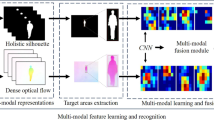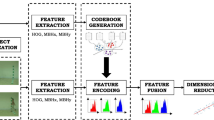Abstract
Gait recognition, as one of the new biometric techniques, mainly judges and identifies a target pedestrian through its walking posture. Gait recognition is effective at long distances, difficult to camouflage and requires no contact or cooperation with the target pedestrian. However, the accuracy of gait recognition is affected by external factors, such as the shooting angle of the video, the clothes and bags worn by the target. In this paper, we solve the above problems based on two aspects. Firstly, a gait recognition method based on MSM Loss is proposed. In this way we are able to extract more discriminative spatio-temporal features; Secondly, we also introduce a new input method, which makes each input sequence more closely related, thus improving the gait recognition rate. Finally, the proposed method is verified on the CASIA-B and OU-MVLP dataset. In CASIA-B, the average recognition rate is obtained under the walking conditions of normal, with bags and with clothes. With rank-1 accuracy under LT, the method proposed in this paper can reach 96.4% under NM, 89.1% under BG and 71.2% under CL. And under the normal walking conditions, our method performs better compared with the best existing gait recognition methods. And in OU-MVLP, we get 87.5% accuracy.













Similar content being viewed by others
Abbreviations
- MSM Loss:
-
Margin Sample Mining Loss
- NM:
-
Walking under normal condition
- BG:
-
Walking with bag
- CL:
-
Walking with clothes
- CNN:
-
Convolutional neural network
- GAN:
-
Generative adversarial network
- DRL:
-
Disentangled representation learning
- PEI:
-
Period energy image
- FC:
-
Full connection layer
- ST:
-
Small sample training
- MT:
-
Medium sample training
- LT:
-
Large sample training
References
Bashir K, Xiang T, Gong S (2009) Gait recognition using gait entropy image, in: 3rd International Conference on Imaging for Crime Detection and Prevention, ICDP 2009, London, UK, December 3, 2009, IET / IEEE, 1–6
Chao H, He Y, Zhang J, Feng J (2019) Gaitset: Regarding gait as a set for cross-view gait recognition, in: The Thirty-Third AAAI Conference on Artifificial Intelligence, AAAI 2019, The Thirty-First Innovative Applications of Artifificial Intelligence Conference, IAAI 2019, The Ninth AAAI Symposium on Educational Advances in Artifificial Intelligence, EAAI 2019, Honolulu, Hawaii, USA, January 27–February 1, 2019, AAAI Press, 8126–8133.
Cho C, Chao W, Lin S, Chen Y (2009) A vision-based analysis system for gait recognition in patients with parkinson’s disease. Expert Syst Appl 36(3):7033–7039
Fan C, Peng Y, Cao C, Liu X, Hou S, Chi J, Huang Y, Li Q, He Z (2020) Gaitpart: Temporal part-based model for gait recognition, in: 2020 IEEE/CVF Conference on Computer Vision and Pattern Recognition, CVPR 2020, Seattle, WA, USA, June 13–19, 2020, Computer Vision Foundation/IEEE, 14213–14221
Fu Y, Wei Y, Zhou H, Shi G, Huang X, Wang Z, Yao TS Huang, Horizontal pyramid matching for person reidentifification, CoRR abs/1804.05275. arXiv:1804.05275
Han J, Bhanu B (2006) Individual recognition using gait energy image. IEEE Trans Pattern Anal Mach Intell 28(2):316–322
He Y, Zhang J, Shan H, Wang L (2019) Multi-task gans for view-specifific feature learning in gait recognition. IEEE Trans Inf Forensics Secur. 14(1):102–113
Hermans A, Beyer L, Leibe B. In defense of the triplet loss for person reidentifification, CoRR abs/1703.07737. arXiv:1703.07737
Hu M, Wang Y, Zhang Z, Little JJ, Huang D (2013) View-invariant discriminative projection for multi-view gait-based human identifification. IEEE Trans Inf Forensics Secur 8(12):2034–2045
Huh J, Seo Y (2019) Understanding edge computing: engineering evolution with artifificial intelligence. IEEE Access 7:164229–164245
Kusakunniran W, Wu Q, Zhang J, Li H, Wang L (2014) Recognizing gaits across views through correlated motion co-clustering. IEEE Trans Image Process 23(2):696–709
Lai DTH, Begg RK, Palaniswami M (2009) Computational intelligence in gait research: a perspective on current applications and future challenges. IEEE Trans Inf Technol Biomed 13(5):687–702
Li X, Makihara Y, Xu C, Yagi Y, Ren M (2020) Gait recognition via 100 semi-supervised disentangled representation learning to identity and covariate features, in: 2020 IEEE/CVF Conference on Computer Vision and Pattern Recognition, CVPR 2020, Seattle, WA, USA, June 13–19, 2020, Computer Vision Foundation/IEEE, 13306–13316
Liu H, Zhu X, Lei Z, Li SZ (2019) Adaptiveface: Adaptive margin and sampling for face recognition, in: IEEE Conference on Computer Vision and Pattern Recognition, CVPR 2019, Long Beach, CA, USA, June 16–20, 2019, Computer Vision Foundation / IEEE, 11947–11956
Nixon MS, Carter JN, Nash JM, Huang PS, Cunado D, Stevenage SV (1999) Motion analysis and tracking, in: IEEE colloquium on Motion Analysis & Tracking
Park SW, Huh JH, Kim JC (2020) Began v3: avoiding mode collapse in 115 gans using variational inference. Electronics 9(4):688
Park SW, Ko JS, Huh JH, Kim JC. Review on generative adversarial networks: Focusing on computer vision and its applications
Phillips PJ (2002). Human identification technical challenges. International Conference on Image Processing. IEEE.
Sarkar S, Phillips PJ, Liu Z, Vega IR, Grother P, Bowyer KW (2005) The humanid gait challenge problem: data sets, performance, and analysis. IEEE Trans Pattern Anal Mach Intell 27(2):162–177
Shiraga K, Makihara Y, Muramatsu D, Echigo T, Yagi Y (2016) Geinet: View-invariant gait recognition using a convolutional neural network. In 2016 International Conference on Biometrics (ICB), pages 1–8, 1, 7
Stevenage SV, Nixon MS, Vince K (2010) Visual analysis of gait as a cue to identity. Appl Cogn Psychol 13(6):513–526
Sun J, Yang W, Xue J, Liao Q (2020) An equalized margin loss for face recognition. IEEE Trans Multim 22(11):2833–2843
Takemura N, Makihara Y, Muramatsu D, Echigo T, Yagi Y (2018) Multi-view large population gait dataset and its performance evaluation for cross view gait recognition. IPSJ Trans Comput Vis Appl 10:4. https://doi.org/10.1186/s41074-018-0039-6
Tariq M, Shah MA (2017) Review of model-free gait recognition in biometrie systems, in: 23rd International Conference on Automation and Computing, ICAC 2017, Huddersfifield, United Kingdom, September 7–8, 2017, IEEE, 1–7.
Wu Z, Huang Y, Wang L, Wang X, Tan T (2017) A comprehensive study on cross-view gait based human identifification with deep cnns. IEEE Trans Pattern Anal Mach Intell 39(2):209–226
Xiao Q, Luo H, Zhang C. Margin sample mining loss: A deep learning 70 based method for person re-identifification, CoRR abs/1710.00478. arXiv: 1710.00478
Xue W, Ai H, Sun T, Song C, Huang Y, Wang L (2020) Frame-Gan: increasing the frame rate of gait videos with generative adversarial networks. Neurocomputing 380:95–104
Yu S, Tan D, Tan T (2006) A framework for evaluating the effffect of view angle, clothing and carrying condition on gait recognition, in: 18th international conference on pattern recognition (ICPR 2006), 20–24 august 2006, Hong Kong, China, IEEE Computer Society, 441–444.
Yu S, Chen H, Reyes EBG, Poh N (2017) Gaitgan: Invariant gait feature extraction using generative adversarial networks, in: 2017 IEEE Conference on Computer Vision and Pattern Recognition Workshops, CVPR Workshops 2017, Honolulu, HI, USA, July 21–26, 2017, IEEE Computer Society, 532–539
Yu S, Chen H, Wang Q, Shen L, Huang Y (2017) Invariant feature extraction for gait recognition using only one uniform model. Neurocomputing 239:81–93
Funding
This paper is supported by 2021 Key Research and Development Plan of Shaanxi Province (no:2021SF-377).
Author information
Authors and Affiliations
Contributions
Xuan Nie: Conceptualization, Methodology, Software, Writing - Original Draft, Writing - Review & Editing, Supervision, Resources.
Hongmei Li: Conceptualization, Methodology, Software, Validation, Formal analysis, Writing - Original Draft, Investigation.
Corresponding author
Ethics declarations
Conflict of interests
We have no conflict of interests to disclose.
Additional information
Publisher’s note
Springer Nature remains neutral with regard to jurisdictional claims in published maps and institutional affiliations.
Rights and permissions
About this article
Cite this article
Nie, X., Li, H. Gait recognition based on margin sample mining loss. Multimed Tools Appl 82, 969–987 (2023). https://doi.org/10.1007/s11042-022-13019-3
Received:
Revised:
Accepted:
Published:
Issue Date:
DOI: https://doi.org/10.1007/s11042-022-13019-3




